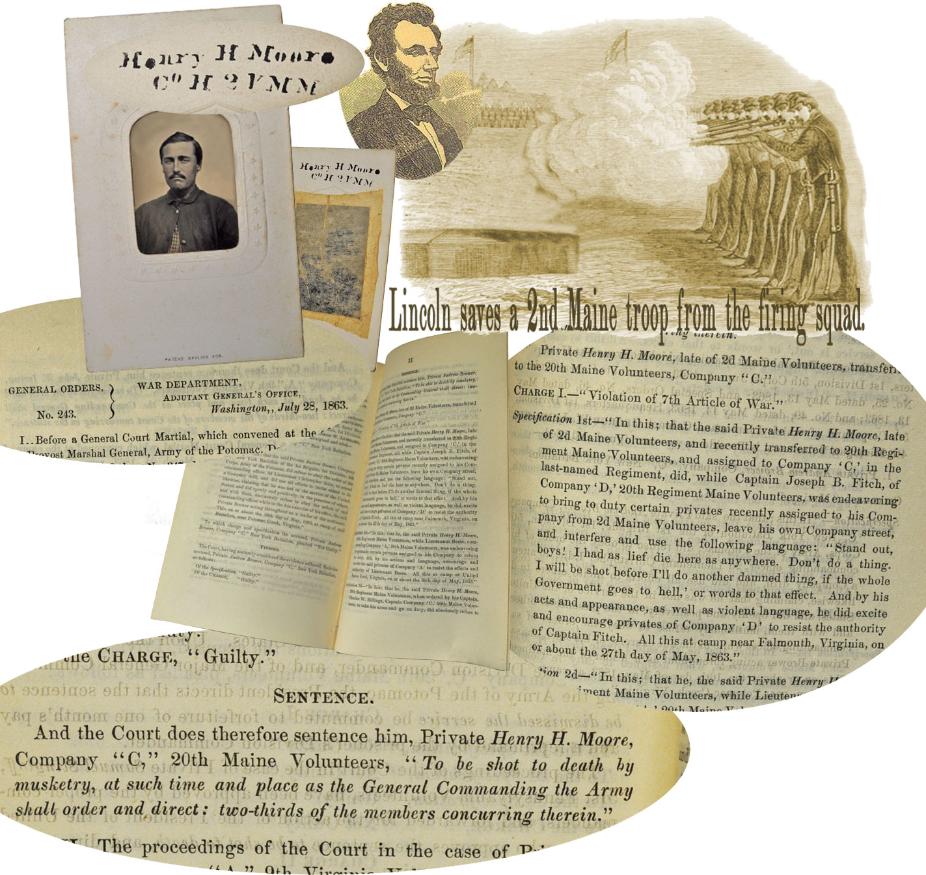
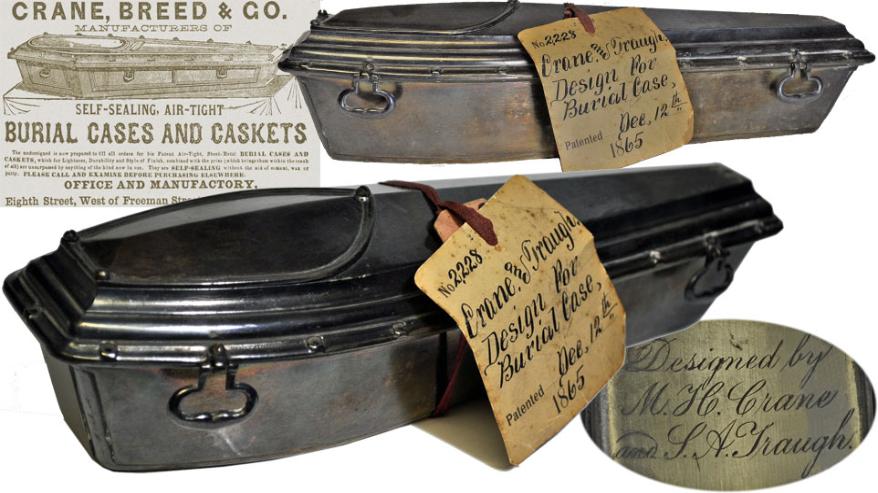
Illustrated above from the Hayes Family Collection is the original Patent model submitted in 1865 by Martin H. Crane and Samuel A. Traugh (listed in period directories as a foreman of Crane, Breed & Co) for an improved seamless, sealable coffin. The model retains its’ original U. S. Patent Office tag recording the award on Pat. 2228 . Company flyers touting the features of its newly designed casket advised:
A delay of days or weeks, awaiting the arrival of absent friends, is entirely practicable. When due attention is given in sealing, which may, with care, be accomplished by anyone . . . bodies may be carried to any part of the globe at any season of the year, with perfect safety.
The new sealing feature in combination with traditional Victorian era toe-pincher shape and removable viewing plate served the Crane & Breed Co. well as recovery of the fallen from burial grounds across the South continued in mass in the earliest post-Civil War period.
Lorem ipsum dolor sit amet, consectetur adipiscing elit. Ut elit tellus, luctus nec ullamcorper mattis, pulvinar dapibus Lorem ipsum dolor sit amet, consectetur adipiscing elit. Ut elit tellus, luctus nec ullamcorper mattis, pulvinar dapibus Lorem ipsum dolor sit amet, consectetur adipiscing elit. Ut elit tellus, luctus nec ullamcorper mattis, pulvinar dapibus



Gen. George F. Shepley
A resident of Portland, Maine, Shepley was commissioned as Col. 12th Maine Volunteer Infantry on 1/20/1861. On 7/18/1862 he was commissioned into the U. S. Vol. Gen. Staff. He served on Mjr. Gen. Butler’s staff. On Union occupation of New Orleans, he was made military commandant of that city then Military Governor of Louisiana. Upon Federal entry into Richmond he was made the Military Governor of that city.
Shown here with the Brady photo of Shepley is his hat device as Colonel of the 12th Maine along with a presentation coffee pot inscribed to the Colonel.
| MaineLegacy.com is here for your edification and enjoyment. Please browse and enjoy and don’t forget to visit our sale site at GunsightAntiques.com |
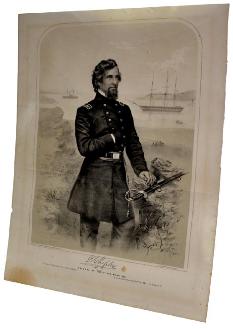
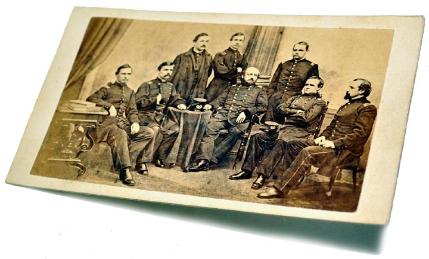
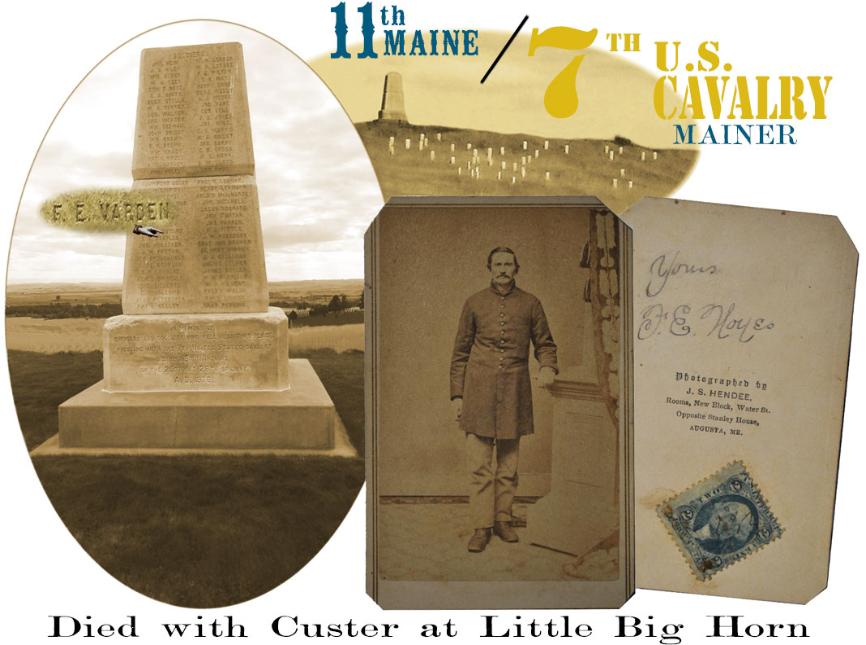
It should be noted here that there were 8 Mainers serving in the 7th U. S. Cavalry in June of 1876 of that number 5 were with the Regiment at Little Bighorn, 4 were killed with one MIA presumed killed All 5 Mainers rest in the mass grave on Last Stand Hill, Little Bighorn Battlefield, Montana.
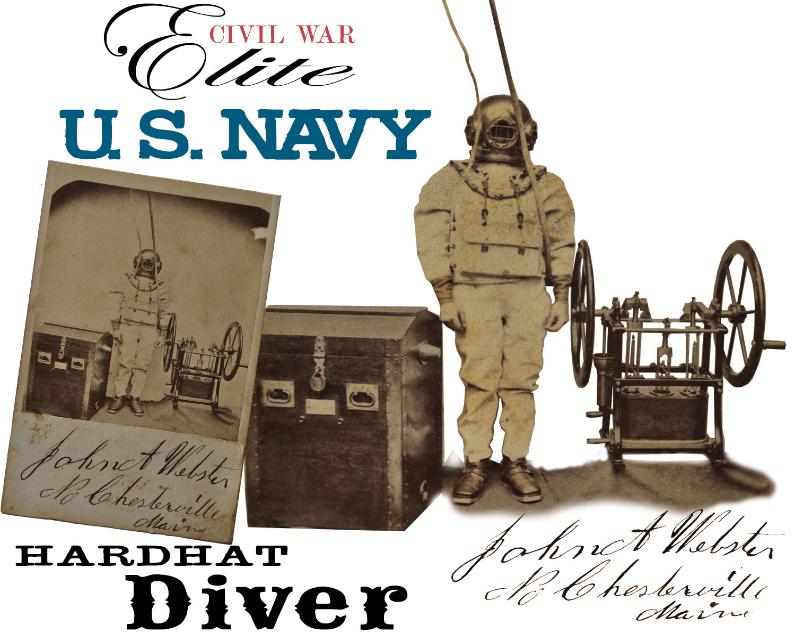
FOR THE HOME FOLKS
Union Navy Diver John A. Webster.
Stands before the camera lens in full armor. His cumbersome gear to include the compressor are of the type produced by the Alfred Hale Co. (a.k.a. Alfred Hale Rubber Co.) of Boston, Massachusetts
Frank E. Noyes was a burly eighteen year old resident of Brunswick, Maine when on November 7, 1861 he enlisted and was mustered in as a Private of Co. A 11th Maine Volunteer Infantry. His soon to become battle hardened 11th Maine moved quickly for the seat of war when the Regiment left Maine for Washington D. C. in under a weeks time. Before his mustering out, Frank Noyes’ 11th Maine would participate in the Siege of Yorktown, the battles of Williamsburg, Fair Oaks, Seven Pines, White Oak Swamp and Malvern Hill with duty at Harrison’s Landing and Port Royal. It was in October of 1863 that Frank Noyes was detached to artillery duty on Morris Island, South Carolina in support of the siege of Fort Wagner and operations against Charleston. Before his mustering out in November 1864, Pvt. Noyes’ 11th Maine served with Gen. Butler’s operations against Petersburg and Richmond with occupation of City Point and Bermuda Hundred and subsequent involvement in action at such as Darbytown Road, Fair Oaks and Chaffin’s Farm. The culmination of service with the 11th Maine Infantry and the close of the Civil War was not the end of military action for Frank E. Noyes as on December 15, 1866 the stuffy Yankee reenlisted, this time to serve in the United States Army where he continued to serve until August 7, 1871 when Noyes deserted only to enlist yet again this time under the alias Frank E. Varden. He was to serve in George Armstrong Custer’s ill-fated 7th U. S. Cavalry . It seems our Brunswick, Maine native was reasonably compatible in his roll with Custer’s Indian Fighters as he had been promoted to the rank 1st Sergeant by June 25 1876 and the infamous Battle of Little Bighorn. The name of 1st Sgt. Noyes is inscribed on the Last Stand Hill memorial as it appeared in 7th Cavalry records, F. E. Varden. His remains are interred at the foot of the monument along with his fallen 7th Cavalry mates. The Custer remains were removed for burial at the U. S. Military Academy at West Point.
The full military experience of North Chesterville, (Farmington) Maine resident John A. Webster is unfortunately a bit of an enigma to us at this point, yet in consideration of our image displayed here in full diving armor standing adjacent to a manually powered compressor, his name is clearly worthy of interest and note here. While leaving more specific service details to hopefully be discovered, we know that Webster is recorded as being 22 years of age when on April 17 1861 he enlisted in Portland, Maine as a Landsman in the United States Navy. (Entry level military rank given to naval recruits.) While his photo offers the knowledge that the young Maine farmer served as a Navy Hard Hat Diver little else has been found beyond records of service aboard the USS Sabine, USS OHIO, USS MASSACHUSETTS and the USS BROOKLYN. While reference to the Civil War service of a small group of elite sailors as divers is quite limited, a review of the Official Records of the Union Navy tells us that each Navy Squadron counted a diver among their headcount. Referred to in period reports as armored or submarine divers, such would be better recognized in today’s verbiage as hard hat divers. The Squadron Diver was most frequently used to accomplish emergency ship’s hull inspection and repairs, equipment and machinery recovery, inspection of wrecks both of CSN and Union vessels as well as of sunken blockade runners . One recorded application refers to an 1863 task overcoming the obstructions in Charleston Harbor. While John Webster’s date of separation from the Navy has eluded us, we know he subsequently married a girl from Conway, New Hampshire where he was born and returned home to North Chesterville, Maine where he toiled as a country farmer until on January 17, 1901 the fifty-three year old Navy veteran was killed when he was thrown under the runners of a heavy two horse drawn sled. He is buried in the Webster Cemetary on the North Chesterville Road.


Illustrated above from the Hayes Family Collection is the original Patent model submitted in 1865 by Martin H. Crane and Samuel A. Traugh (listed in period directories as a foreman of Crane, Breed & Co) for an improved seamless, sealable coffin. The model retains its’ original U. S. Patent Office tag recording the award on Pat. 2228 . Company flyers touting the features of its newly designed casket advised:
A delay of days or weeks, awaiting the arrival of absent friends, is entirely practicable. When due attention is given in sealing, which may, with care, be accomplished by anyone . . . bodies may be carried to any part of the globe at any season of the year, with perfect safety.
The new sealing feature in combination with traditional Victorian era toe-pincher shape and removable viewing plate served the Crane & Breed Co. well as recovery of the fallen from burial grounds across the South continued in mass in the earliest post-Civil War period.
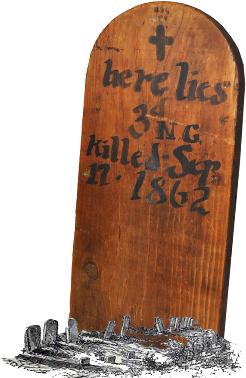
This hastily constructed marker identified the burial location of casualties of the 3rd North Carolina after the Battle of Antietam (Sharpsburg). It serves to remind us here that both Union and the Confederacy dearly paid the WAGES OF WAR. Less frequently able to properly care for their fallen, this marker for Confederate loss was likely placed by area citizens who in the aftermath tended to the gruesome service of caring for the dead . With a Confederate casualty total well in excess of 10,000, men lay unburied for days leading to additional losses of an untold number of local citizens from disease. The Adjutant of the devastated 3rd North Carolina later recorded that with five hundred and twenty of the Regiment engaged, only one hundred and ninety could be accounted for after the battle.

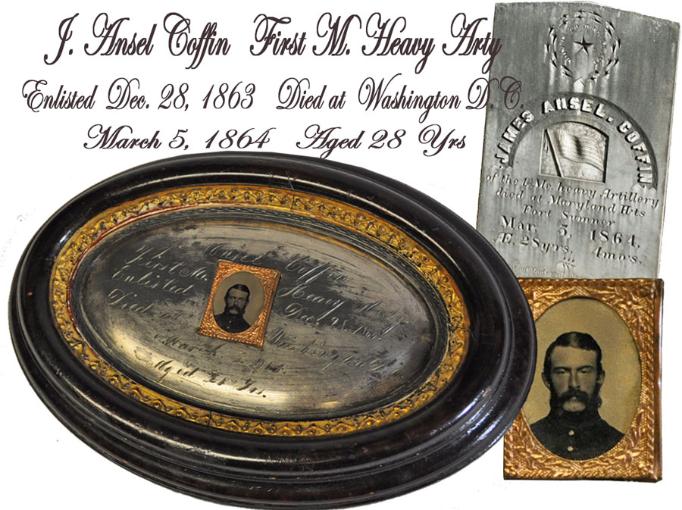
Recorded as James A. Coffin when he mustered in as a Private of
Co. E 1st Maine Heavy Artillery. Pvt. J. Ansel Coffin died in
just over two months from his mustering in. The Regimental
Hospital Surgeon recorded the cause of death as encephalitis.
Arrangements were made to recover and return his remains to
Maine to be laid to rest in the family plot in the North Lovell
Cemetery.
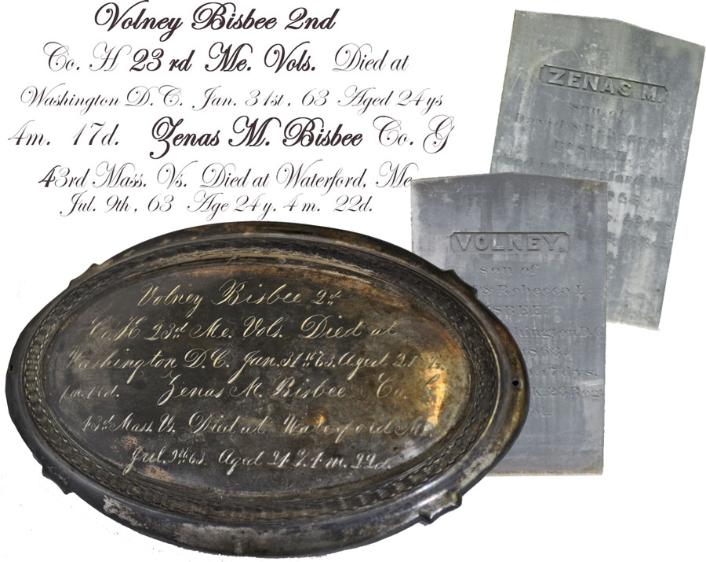
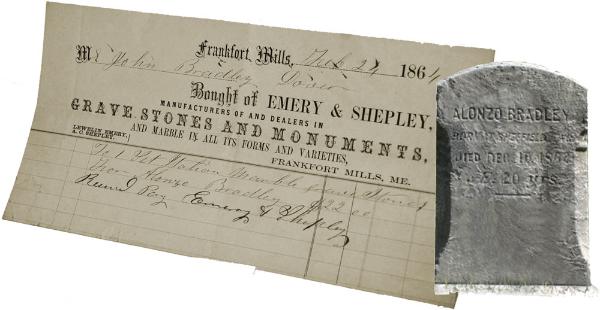
This February 1862 dated receipt was issued by Emery & Shepley, Frankfort Mills, Maine grave stone and monument dealers, to John Bradley for the marker of his diseased son Alonzo Bradley. Nineteen year old Alonzo and his eighteen year old brother Alfonzo Bradley were residing in Dover, Maine with their father, step-mother and five siblings when on July 15, 1861 the adventurous brothers enlisted and mustered in together as Privates of Co. A 6th Maine Volunteer Infantry. As members of the 6th Maine the brothers Bradley saw action at the Siege of Yorktown, Williamsburg, Gaines’ Mill, action at Savage Station, White Oak Swamp and Malvern Hill before they were both taken as prisoners of war at Centerville, Virginia September 2, 1862. Upon parole Alonzo Bradley was taken to Hammond U. S. Army General Hospital at Point Lookout Maryland where he died of chronic diarrhea on December 10, 1862. Brother Alfonzo was returned to duty with the hard fought 6th Maine Infantry and though wounded at the Battle of Fredericksburg, Alfonzo Bradley would muster out with his Regiment in August of 1864. He returned to Dover where he lived to the age of seventy- three before he was laid to rest with brother Alonzo in the family plot at Dover Cemetery in what is now Dover-Foxcroft, Maine.
A classic example of Maine Yankee frugality, when the Waterford, Maine Bisbees’ lost a second son to the Civil War in six months’ time, they opted to remember both boys on a single plaque. Young Volney Bisbee was 20 years of age when he enlisted and mustered in on September 29, 1862 as a Private of Co, K 23rd Maine Volunteer Infantry. He would die of tuberculosis at Emory U. S. Army Hospital in just four short months with burial in Washington D. C. Loved ones made arrangements to recover Cpl. Volney Bisbee’s remains for reinternment in the family plot, Bisbeetown Cemetery, Oxford County, Maine. Older brother Zenas Bisbee had relocated to Massachusetts before the Civil War where he worked in a shoe manufactory as a stitcher before he mustered in on August 28, 1862 as a Private of Co. G 43rd Massachusetts Infantry. He was discharged for disability on 4/3/1863 at New Berne, N.C. A medical notation recorded March 25 1863 at Camp Rogers, New Bern – Taken sick on the expedition to Goldsboro December last. Since that time has not been able to do any duty. He has had the diarrhea most of the time. He has had a bad cough and has lost a great deal of flesh. He was well before the expedition. He was subsequently diagnosed by the Regimental Surgeon as having phthifis pulmonalis ( tuberculosis ) with chronic diarrhea and night sweats. Ruled totally disabled Zenas Bisbee was discharged to be sent home to Waterford where he died on July 9th 1863. He was laid to rest next to his brother in Bisbeetown Cemetery.










Born in Bangor, Maine, John Francis Appleton was the oldest son of Maine Supreme Court Chief Justice John Appleton. A graduate of Bowdoin College in 1860, upon the outbreak of the Civil War the young lawyer quickly set about raising a company of recruits of the 12th Maine Volunteer Infantry and was commissioned as Captain on November 15, 1861 in command of Co. H of the 12th Maine. Written by a fellow officer in a published account of action at the Battle of Port Hudson, it was said that Capt. Appleton alone, among ten thousand men who fought that day, mounted the Rebel parapet and stood there facing the whole Rebel Army, a mark for a thousand rifles. A Confederate officer told me, after the surrender, that as he saw that young man standing there so calm and brave, he could not bear to see him die, and he told his men not to fire upon him. For this and other notable acts Capt. Appleton was commended by Gen. Butler. He would be promoted to the Colonelcy of the 9th Regiment of Infantry, Corps d’Afrique in June of 1863 and assigned command of a brigade of free Blacks. The 9th was reorganized to become the 81st United States Colored Troops in 1864. Col. Appleton was brevetted Brigadier General, US Volunteers on March 13, 1865, joining the ranks of another Union general from Bangor serving in Louisiana, Cyrus Hamlin, the son of Vice President Hannibal Hamlin.
Members of the JOHN F. APPLETON G.A.R. POST No. 25 relax in front of their headquarters at the 1929, 63rd G.A.R. National Encampment in Portland, Maine.


 While we are required by the magnitude of our accumulation to leave some things behind, we couldn’t possibly close this section on the 2nd Maine Infantry without sharing this tidbit from a period newspaper with our fellow enthusiasts. You may make of it what you will.
While we are required by the magnitude of our accumulation to leave some things behind, we couldn’t possibly close this section on the 2nd Maine Infantry without sharing this tidbit from a period newspaper with our fellow enthusiasts. You may make of it what you will. Despite a tumultuous start with the 20th Maine, the transferred three year men of the 2nd Maine served bravely with the 20th Maine. Most recognized of these today is Sgt. Andrew J. Tozier a stodgy Irishman who’s roll as regimental flag bearer with the 20th on Little Round Top at Gettysburg won Congressional Medal of Honor recognition and was immortalized in the Michael Shaara’s historical novel Killer Angels and the 1993 blockbuster movie adaptation Gettysburg. Worthy of a more complete representation of Sgt. Toziers story, we will be doing a more complete presentation on this fascinating character and his lifelong attachment to Joshua Chamberlain sometime in the future.

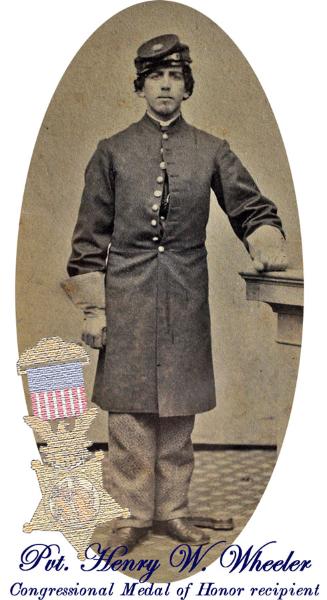

 Henry W. Wheeler was 24 years of age when he enlisted and was mustered in on May 28, 1861 as Private Co. I 2nd Maine. He was awarded the Congressional Medal of Honor for gallantry at 1st Bull Run when, after a number of his comrades had been cut down and lay exposed on the battlefield, Wheeler volunteered to accompany Col. Jameson in removing the fallen 2nd Mainers from a field still under the heavy fire of Confederate artillery and musketry. Wounded at 2nd, Bull Run Henry Wheeler mustered out with his regiment on June 9, 1863. The consummate soldier, Henry traveled to Port Hudson, Louisiana where he re-enlisted and was commissioned as 1st. Lt. Co F 81st U. S. Colored Troops. Henry Wheeler died in 1904. He was buried in Section 3 of Arlington National Cemetery where his grave stone recognizes promotion to Brevet Captain 81st USCT.
Henry W. Wheeler was 24 years of age when he enlisted and was mustered in on May 28, 1861 as Private Co. I 2nd Maine. He was awarded the Congressional Medal of Honor for gallantry at 1st Bull Run when, after a number of his comrades had been cut down and lay exposed on the battlefield, Wheeler volunteered to accompany Col. Jameson in removing the fallen 2nd Mainers from a field still under the heavy fire of Confederate artillery and musketry. Wounded at 2nd, Bull Run Henry Wheeler mustered out with his regiment on June 9, 1863. The consummate soldier, Henry traveled to Port Hudson, Louisiana where he re-enlisted and was commissioned as 1st. Lt. Co F 81st U. S. Colored Troops. Henry Wheeler died in 1904. He was buried in Section 3 of Arlington National Cemetery where his grave stone recognizes promotion to Brevet Captain 81st USCT.
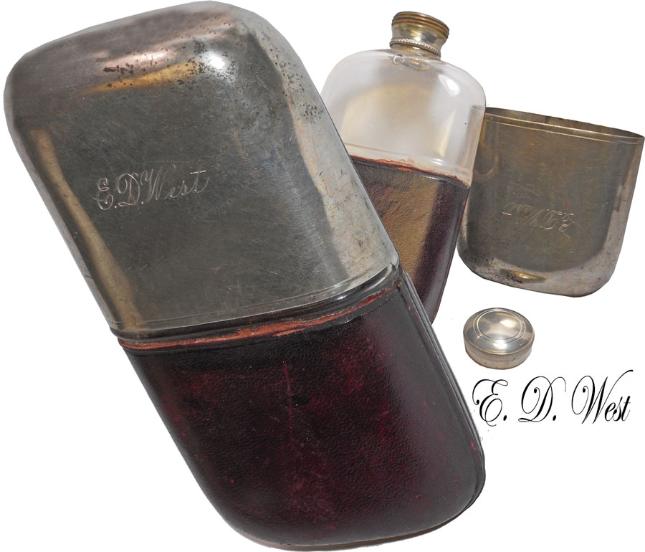
Hand carved laurel root pipe with the American eagle, laurel leaves and “J. S. SMALL Co. F, 2nd Me., FREDRICK” (Likely Frederick Maryland where the 2nd was camped for a time.) Quality carving with a tin insert to prevent burn out and a silver insert (probably from a flattened spoon) at the stem. This Carmel, Maine trooper enlisted and was mustered in as Cpl. Co. F 2nd Maine. He mustered out with the 2nd on June 4, 1863 then re-enlisted October 3, 1864 as a Private of Co. F 1st Maine Heavy Artillery.
Inscribed pocket flask of Franklin, Maine resident Edward D. suffered at 2nd Bull Run. West had enlisted and mustered in on December 12, 1861 as a Private of Co I, 2nd Maine Infantry. While he gave his age as 18 for legal enlistment, in 1860 the U. S. Census recorded his age as 14, an all too common occurrence as young boys yearned for the excitement and gallantry of military service. Pvt. West was mortally wounded on August 30, 1862 at 2nd Bull Run and died on October 30, 1862.
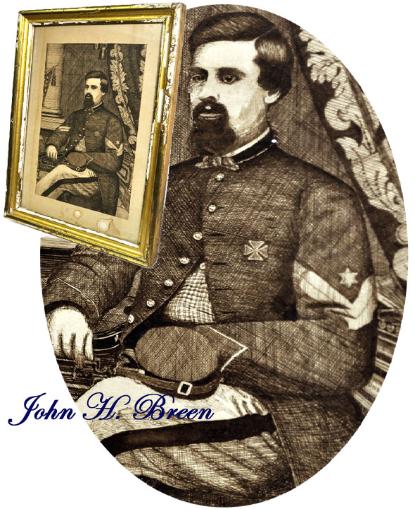
Shown here in a pen and ink rendering done while Cpl. John H Breen was recovering from wounds at the, Annapolis, Maryland, Army Hospital, Cpl. Breen was one of the 2nd Maine Volunteers transferred to the 20th Maine just before Gettysburg. Shown here after amputation of his left hand, more detail of Breen’s Civil War service may be found in one of our earlier presentations on page 15.

War Department General Order #243 records the Court Martial of several 2nd Maine Troopers who, expecting to be mustered out with their 2nd Regiment at the end of its term in June of 1863 but instead found themselves transferred to the 20th Maine Infantry where they were expected to complete their enlistment. Unlike the majority of 2nd Maine members who had enlisted for the term of the Regiment, the very unhappy fellows who found themselves instead transferred to the 20th, had entered service for a fixed period separate and apart from the term of the Regiment. While most and eventually all the effected troopers took up arms and served with Col. Joshua Chamberlain’s regiment there was a small number who initially refused. Their action was viewed as all out mutiny and Pvt. Henry Moore was the major instigator as he encouraged others of the old 2nd to join in the rebellious action. Henry was quickly made an example of as Court Martial proceedings were brought against the stubborn Bangor cooper, turned soldier, then mutineer. Considering action brought against the primary instigator all holdouts from the old 2nd Maine quickly accepted their 20th Regiment comrades as comrades in arms except Pvt. Henry H. Moore who was found guilty as charged and was sentenced to be shot to death by musketry. Moore’s sentence before an Army firing squad was commuted by President Abraham Lincoln to imprisonment at hard labor for the war’s duration. Henry Moore was finally persuaded to pick up arms with the 20th and was returned to that regiment in April 1864. He was wounded fighting with the 20th Maine at Bethesda Church on June 3, 1864 and was discharged at the end of his original enlistment of service Sept. 20 1864.
